Domed city
A domed city is a hypothetical structure that encloses a large urban area under a single roof. In most descriptions, the dome is airtight and pressurized, creating a habitat that can be controlled for air temperature, composition and quality, typically due to an external atmosphere (or lack thereof) that is inimical to habitation for one or more reasons. Domed cities have been a fixture of science fiction and futurology since the early 20th century, and may be situated on Earth, a moon or other planet.

Origin
It is not clear exactly when the concept of a domed city first appeared. The phrase "domed city" had come into use by the 19th century in a different sense, meaning a skyline with dome-topped buildings. One catalogue of early science fiction mentions the 1881 fantasy Three Hundred Years Hence by British author William Delisle Hay (not to be confused with an earlier novel of the same title, by Mary Griffith). Hay's book describes a future civilization where most of humanity lives in glass-domed cities beneath the sea, allowing the surface of the earth to be used primarily for agriculture. Several examples from the early 20th century are also listed.[1]
In fiction
Authors used domed cities in response to many problems, sometimes to the benefit of the people living in them and sometimes not. The problems of air pollution and other environmental destruction are a common motive, particularly in stories of the middle to late 20th century. As in the Pure trilogy of books by Julianna Baggott. In some works, the domed city represents the last stand of a human race that is either dead or dying.[2] The 1976 film Logan's Run shows both of these themes. The characters have a comfortable life within a domed city, but the city also serves to control the populace and to ensure that humanity never again outgrows its means.[3]
The domed city in fiction has been interpreted as a symbolic womb that both nourishes and protects humanity. Where other science fiction stories emphasize the vast expanse of the universe, the domed city places limits on its inhabitants, with the subtext that chaos will ensue if they interact with the world outside.[4]
In some works cities are getting "domed" to quarantine its inhabitants.
Engineering proposals
During the 1960s and 1970s, the domed city concept was widely discussed outside the confines of science fiction. In 1960, visionary engineer Buckminster Fuller described a 3 km geodesic dome spanning Midtown Manhattan that would regulate weather and reduce air pollution.[5] A domed city was proposed in 1979 for Winooski, Vermont[6] and in 2010 for Houston.[7]
In order to test whether an artificial closed ecological system was feasible, Biosphere 2 (a complex of interconnected domes and glass pyramids) was constructed in the late 1980s. Its original experiment housed eight people and remains the largest such system attempted to date.
In 2010, a domed city known as Eco-city 2020 of 100,000 was proposed for the Mir mine in Siberia.[8] In 2014, the ruler of Dubai announced plans for a climate-controlled domed city covering an area of 48 million square feet (4.5 square kilometers),[9] but as of 2016, the project has been redesigned without the dome.[10]
See also
- Dyson sphere
- The Caves of Steel, 1953 science fiction novel set in a domed New York City
Notes
- Bleiler, Everett F. (1990). Science Fiction: The Early Years.
- Yanarella, Ernest J. (2001). The Cross, the Plow and the Skyline.
- Díaz-Diocaretz, Myriam (2006). The Matrix in Theory and Practice.
- Kreuziger, Frederick A. (1986). The Religion of Science Fiction.
- Weird Science Archived 2011-07-23 at the Wayback Machine The New Yorker on Fuller dome over Manhattan
- "Environment: A Dome for Winooski?". TIME.com. 10 December 1979.
- Discovery Channel: A Dome over Houston Archived July 22, 2010, at the Wayback Machine
- Geere, Duncan (17 November 2010). "Russia plans domed city in Siberian mine". Wired UK.
- "World's first climate-controlled domed city to be built in Dubai (PHOTOS)". RT International.
- "Dubai's Mall of the World no longer going to be globe's largest". What's On. 12 January 2016.
